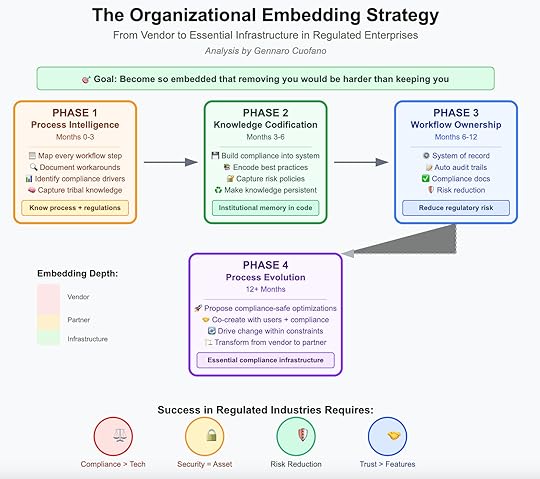The Organizational Embedding Strategy to win in Enterprise AI
 Becoming Part of the Enterprise DNA
Becoming Part of the Enterprise DNAThe most successful implementations weren’t tools—they were transformations. Your goal isn’t to sell software. It’s to become so embedded in the enterprise’s operations that removing you would be harder than keeping you.
Phase 1: Process Intelligence (Months 0-3) Work within the authorized pilot to achieve deep process understanding. Map every step of current workflows, including unofficial workarounds that exist for compliance reasons. Document decision points and regulatory requirements that drive complexity. Identify institutional knowledge that ensures compliance but isn’t documented. Become the expert on both their process AND the regulations that shaped it.Phase 2: Knowledge Codification (Months 3-6) Build their compliance expertise into your system permanently. Create templates that encode both best practices and regulatory requirements. Capture their risk policies and audit preferences in reusable components. Make their institutional knowledge persistent and auditable—critical when experienced employees retire.Phase 3: Workflow Ownership (Months 6-12) Become the system of record for regulated processes. Handle exceptions automatically while maintaining audit trails. Generate compliance documentation required for regulatory reviews. Position yourself as reducing regulatory risk, not just improving efficiency.Phase 4: Process Evolution (12+ Months) Propose optimizations backed by compliance-safe data. Co-create new workflows with both users AND compliance teams. Drive organizational change that satisfies both efficiency and regulatory needs. Transform from vendor to compliance partner to essential infrastructure.The Bottom Line: Your 12-Month Path to Enterprise SuccessMonths 0-3: Authorized Entry Launch through innovation labs or transformation offices with proper authorization. Identify middle-management champions who can navigate politics. Document wins within controlled pilots that prove value. Build trust through compliance respect, not disruption.Months 3-6: Departmental Validation Scale from pilot to department with security approval. Prove ROI metrics that include risk reduction. Navigate procurement with your champion’s guidance. Establish value that satisfies both efficiency and safety requirements.Months 6-9: Enterprise Expansion Add enterprise features required for full deployment. Scale across departments through formal channels. Build executive support through proven compliance and efficiency. Lock in enterprise agreements based on demonstrated risk reduction and value.Months 9-12: Organizational Transformation Push for process improvements within regulatory constraints. Expand use cases based on proven compliance capabilities. Become embedded in their compliance and operational infrastructure. Plan multi-year partnership, not just vendor relationship.The Harsh Reality CheckThis playbook only works if you accept certain harsh realities about enterprise AI adoption in regulated industries:
Compliance beats technology. The best model doesn’t win. The most compliant one does. Accept that inferior technology with superior compliance will beat you every time.Security reviews aren’t obstacles—they’re prerequisites. Embrace them instead of resenting them. Learn to navigate rather than circumvent. Use security as your differentiator, not excuse.You’re building for three masters: users who need efficiency, compliance who needs safety, and executives who need both. Your champion in the middle must satisfy all three.Risk reduction beats efficiency gains. One compliance violation costs more than years of efficiency gains. Depth of compliance beats speed of deployment. Audit success beats ROI every time in regulated industries.Trust beats features. It’s better to solve one workflow completely and compliantly than ten workflows partially. Embed deeply into their compliance framework rather than integrate broadly. Become essential to their regulatory posture, not just their productivity.The enterprises that will succeed with AI are those that find partners willing to do the hard work of compliant organizational transformation, not just technology deployment. The question isn’t whether you have the best AI—it’s whether you’re willing to embed yourself deeply enough into their regulatory and operational reality to make them successful.
The $30-40 billion in failed enterprise AI investment isn’t a disaster—it’s your opportunity. These regulated enterprises need partners who understand that compliance and transformation aren’t opposites—they’re prerequisites for each other. Be that partner, and the enterprise AI market is yours.

The post The Organizational Embedding Strategy to win in Enterprise AI appeared first on FourWeekMBA.



